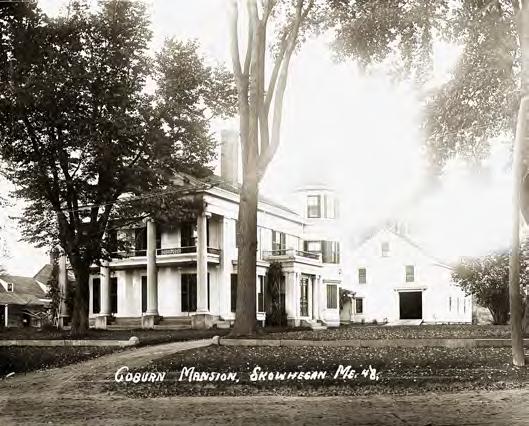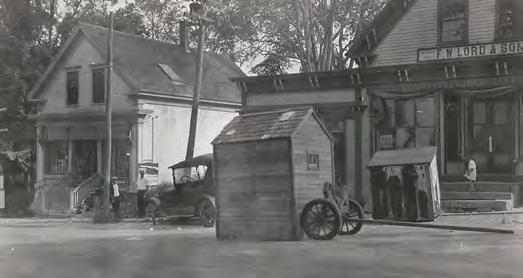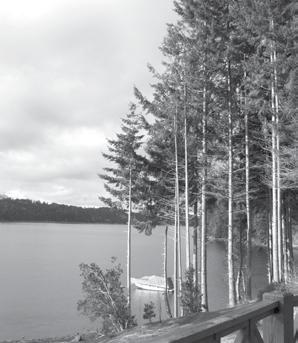
4 minute read
Canaan’s Abner Coburn
Maine’s most philanthropic governor
by Charles Francis
Advertisement
In 1882 William Rogers of Bath launched one of the most famous Downeasters to slide down the ways of any Maine shipyard. She was the Abner Coburn. Rogers named her for former governor Abner Coburn. The Abner Coburn was employed in the China trade for some twenty years, and then in the West Coast lumber trade. She ended her days as a salmon fisher in the Bering Sea.
Today her memory is preserved in one of the more famous marine paintings of the late nineteenth century, The Famous Abner Coburn Being Led to the Sea by Dolphins by Charles Robert Patterson. Charles Robert Patterson’s painting is not the only nineteenth-century artifact to preserve Abner Coburn’s name. Certificates bearing his name from the Skowhegan Savings Bank, for which Coburn served as first president from 1869 to 1885, have been known to go for more than a hundred dollars at auction. Coburn’s name is also closely associated with Colby College, the University of Maine, and Virginia Union University. In fact, the latter two institutions have halls bearing his name. And, of course, Coburn’s hometown of Skowhegan has Coburn Park.
When Mainers think of governors who have been philanthropists, the name Percival Baxter is the one that almost always comes to mind. But long before Baxter was laying the foundations of Baxter State Park and the Baxter School for the Deaf, Abner Coburn was setting the standard for philanthropy in Maine. In fact, when one translates the dollar of Coburn’s days into today’s dollar, the extent of Coburn’s largesse is awe-inspiring.
Abner Coburn was first and fore- most an extremely savvy and successful businessman. In fact, there is a story from his very early years that has attained an almost legendary status that illustrates his business acumen. When Coburn was fourteen, his father, Eleazer, charged him with the sole responsibility of driving a herd of cows from their Canaan farm to Boston for sale. The journey would have been an accomplishment for an adult, but for fourteen-year-old Abner, it must have been a major odyssey. Upon arriving in Boston, Coburn found the price for cattle at an all-time low. He made a decision to drive his herd out of the city. He held them on some good pastureland where they fattened until cattle prices rose again. When Coburn took his cattle back to Boston, he was able to sell them above the market price, thus justifying his father’s faith in his business sense.
Abner Coburn was born in a part of Canaan which is now included in Skowhegan. His date of birth is usually given as March 22, 1803. However, Coburn himself gave it as 1804 on several occasions. Coburn’s father, Eleazer, was a farmer and surveyor. In fact, he was Maine State Timber Surveyor. (cont. on page 64)
(cont. from page 63)
For this reason, the elder Coburn knew the value of state-owned timberlands better than anyone else in Maine. It was a knowledge that he passed on to his sons, Abner and Philander. In the late 1820s and early 1830s, Maine began selling off its public lands for as little as fifteen cents an acre. Eleazer Coburn used his extensive knowledge gained as Maine State Timber Surveyor to invest heavily in the burgeoning timber industry by purchasing thousands of acres of public lands. These acres formed the base of Coburn Brothers Company, which at one point controlled some two hundred thousand acres in northwestern Maine.
Abner Coburn’s political career began in 1838, when he was elected to the first of two terms in the Maine Legislature. After supporting General Winfield Scott, the last Whig to launch a meaningful run for the presidency, Coburn joined with James O. Blaine and Hannibal Hamlin to become one of the founding fathers of the Maine Republican Party. He served on the Executive Council of Anson Morrill, Maine’s first Republican governor, in 1855. In 1860 he was a member of the Maine Electoral College for Abraham Lincoln. In 1863 he became the state’s last Civil War governor. As governor, Coburn was instrumental in guiding the state toward applying the proceeds from the sale of its Morrill Land Grant towards establishing a state land grant college, rather than turning the money over to Bowdoin or Colby to administer. This, of course, led to the founding of what is now the University of Maine System.
Abner Coburn was involved in a wide variety of business ventures in Maine. Besides serving as chief administer for the Coburn Brothers Company’s vast timber operations, he was instrumental in establishing the Coburn Steamship Company on Moosehead Lake. In addition, he built the fabulous Forks Hotel at the confluence of the Dead and Kennebec Rivers.
Like everything else the Coburns did, the Forks Hotel was built on a grand scale and, of course, quickly became known as one of the most luxurious hotels of the period. The threeand-one-half-story hotel boasted a hundred rooms, and one of the largest stables in the northeast. Broad verandas commanded an expansive view of the Kennebec River. Each room had its own woodstove. One story, which may or may not be true, is about the Forks selling alcohol during the time when Maine law forbade the sale of spirits. As the story goes, the hotel was so popular in the region that local residents maintained a grapevine to alert hotel employees whenever the sheriff was about to make a raid. Supposedly, during the summertime all the hotel’s liquor would be loaded onto a boat that was rowed up the Dead River and hidden until the sheriff had finished his inspection. In the winter, a hay-filled sleigh was used to transport the hotel’s bottles of sin.
It is as a philanthropist that Abner Coburn should be remembered, however. Altogether, he gave almost one million dollars to various causes. He gave some $200,000 to Colby College, on whose board of trustees he served as vice president. He gave $100,000 to the Maine College of Agriculture and Mechanical Arts, which is today’s University of Maine. Another $200,000 went to the American Baptist Home Missionary Society, and $100,000 went to the American Baptist Missionary Union.
Abner Coburn, along with his brother Philander, gave Skowhegan the land overlooking Big Eddy to build Coburn Park. Somewhat ironically, however, in 1998 the Abner Coburn House in Skowhegan was listed as one of Maine’s most endangered historic properties. The privately owned home was simply in need of preventive maintenance.
Abner Coburn’s legacy is a notable one. Perhaps the most remarkable thing is that Coburn never married, and for that reason had no children. Yet, for much of his life his major concern was the betterment of future generations.
Discover Maine Magazine is published eight times each year in regional issues that span the entire State of Maine. Each issue is distributed for pick up, free of charge, only in the region for which it is published.
It is possible to enjoy Discover Maine year ‘round by having all eight issues mailed directly to your home or office. Mailings are done four times each year.

Name Address Phone






